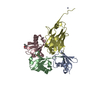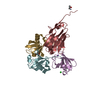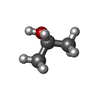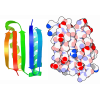[English] 日本語
 Yorodumi
Yorodumi- PDB-8a67: Branched Lys48- and Lys63-linked tri-ubiquitin (K48-K63-Ub3) in c... -
+ Open data
Open data
- Basic information
Basic information
| Entry | Database: PDB / ID: 8a67 | ||||||||||||
|---|---|---|---|---|---|---|---|---|---|---|---|---|---|
| Title | Branched Lys48- and Lys63-linked tri-ubiquitin (K48-K63-Ub3) in complex with matured synthetic nanobody NbSL3.3Q (3rd generation) | ||||||||||||
 Components Components |
| ||||||||||||
 Keywords Keywords | SIGNALING PROTEIN / Branched Ubiquitin / Nanobody / complex | ||||||||||||
| Function / homology |  Function and homology information Function and homology information | ||||||||||||
| Biological species |  Homo sapiens (human) Homo sapiens (human)synthetic construct (others) | ||||||||||||
| Method |  X-RAY DIFFRACTION / X-RAY DIFFRACTION /  SYNCHROTRON / SYNCHROTRON /  MOLECULAR REPLACEMENT / Resolution: 1.86 Å MOLECULAR REPLACEMENT / Resolution: 1.86 Å | ||||||||||||
 Authors Authors | Lange, S.M. / Kulathu, Y. | ||||||||||||
| Funding support |  United Kingdom, European Union, 3items United Kingdom, European Union, 3items
| ||||||||||||
 Citation Citation |  Journal: Nat.Struct.Mol.Biol. / Year: 2024 Journal: Nat.Struct.Mol.Biol. / Year: 2024Title: VCP/p97-associated proteins are binders and debranching enzymes of K48-K63-branched ubiquitin chains. Authors: Lange, S.M. / McFarland, M.R. / Lamoliatte, F. / Carroll, T. / Krshnan, L. / Perez-Rafols, A. / Kwasna, D. / Shen, L. / Wallace, I. / Cole, I. / Armstrong, L.A. / Knebel, A. / Johnson, C. / ...Authors: Lange, S.M. / McFarland, M.R. / Lamoliatte, F. / Carroll, T. / Krshnan, L. / Perez-Rafols, A. / Kwasna, D. / Shen, L. / Wallace, I. / Cole, I. / Armstrong, L.A. / Knebel, A. / Johnson, C. / De Cesare, V. / Kulathu, Y. #1:  Journal: Biorxiv / Year: 2023 Journal: Biorxiv / Year: 2023Title: Comprehensive approach to study branched ubiquitin chains reveals roles for K48-K63 branches in VCP/p97-related processes Authors: Lange, S.M. / McFarland, M.R. / Lamoliatte, F. / Kwasna, D. / Shen, L. / Wallace, I. / Cole, I. / Armstrong, L.A. / Knebel, A. / Johnson, C. / De Cesare, V. / Kulathu, Y. #2: Journal: Acta Crystallogr D Biol Crystallogr / Year: 2010 Title: PHENIX: a comprehensive Python-based system for macromolecular structure solution. Authors: Paul D Adams / Pavel V Afonine / Gábor Bunkóczi / Vincent B Chen / Ian W Davis / Nathaniel Echols / Jeffrey J Headd / Li-Wei Hung / Gary J Kapral / Ralf W Grosse-Kunstleve / Airlie J McCoy ...Authors: Paul D Adams / Pavel V Afonine / Gábor Bunkóczi / Vincent B Chen / Ian W Davis / Nathaniel Echols / Jeffrey J Headd / Li-Wei Hung / Gary J Kapral / Ralf W Grosse-Kunstleve / Airlie J McCoy / Nigel W Moriarty / Robert Oeffner / Randy J Read / David C Richardson / Jane S Richardson / Thomas C Terwilliger / Peter H Zwart /  Abstract: Macromolecular X-ray crystallography is routinely applied to understand biological processes at a molecular level. However, significant time and effort are still required to solve and complete many ...Macromolecular X-ray crystallography is routinely applied to understand biological processes at a molecular level. However, significant time and effort are still required to solve and complete many of these structures because of the need for manual interpretation of complex numerical data using many software packages and the repeated use of interactive three-dimensional graphics. PHENIX has been developed to provide a comprehensive system for macromolecular crystallographic structure solution with an emphasis on the automation of all procedures. This has relied on the development of algorithms that minimize or eliminate subjective input, the development of algorithms that automate procedures that are traditionally performed by hand and, finally, the development of a framework that allows a tight integration between the algorithms. #3: Journal: Acta Crystallogr D Biol Crystallogr / Year: 2011 Title: Data processing and analysis with the autoPROC toolbox. Authors: Vonrhein, C. / Flensburg, C. / Keller, P. / Sharff, A. / Smart, O. / Paciorek, W. / Womack, T. / Bricogne, G. | ||||||||||||
| History |
|
- Structure visualization
Structure visualization
| Structure viewer | Molecule:  Molmil Molmil Jmol/JSmol Jmol/JSmol |
|---|
- Downloads & links
Downloads & links
- Download
Download
| PDBx/mmCIF format |  8a67.cif.gz 8a67.cif.gz | 196.8 KB | Display |  PDBx/mmCIF format PDBx/mmCIF format |
|---|---|---|---|---|
| PDB format |  pdb8a67.ent.gz pdb8a67.ent.gz | 124.2 KB | Display |  PDB format PDB format |
| PDBx/mmJSON format |  8a67.json.gz 8a67.json.gz | Tree view |  PDBx/mmJSON format PDBx/mmJSON format | |
| Others |  Other downloads Other downloads |
-Validation report
| Summary document |  8a67_validation.pdf.gz 8a67_validation.pdf.gz | 491.7 KB | Display |  wwPDB validaton report wwPDB validaton report |
|---|---|---|---|---|
| Full document |  8a67_full_validation.pdf.gz 8a67_full_validation.pdf.gz | 494.9 KB | Display | |
| Data in XML |  8a67_validation.xml.gz 8a67_validation.xml.gz | 30.6 KB | Display | |
| Data in CIF |  8a67_validation.cif.gz 8a67_validation.cif.gz | 45.2 KB | Display | |
| Arichive directory |  https://data.pdbj.org/pub/pdb/validation_reports/a6/8a67 https://data.pdbj.org/pub/pdb/validation_reports/a6/8a67 ftp://data.pdbj.org/pub/pdb/validation_reports/a6/8a67 ftp://data.pdbj.org/pub/pdb/validation_reports/a6/8a67 | HTTPS FTP |
-Related structure data
| Related structure data |  7nbbSC  7npoC S: Starting model for refinement C: citing same article ( |
|---|---|
| Similar structure data | Similarity search - Function & homology  F&H Search F&H Search |
- Links
Links
- Assembly
Assembly
| Deposited unit | 
| ||||||||||||
|---|---|---|---|---|---|---|---|---|---|---|---|---|---|
| 1 | 
| ||||||||||||
| 2 | 
| ||||||||||||
| Unit cell |
|
- Components
Components
-Polyubiquitin- ... , 2 types, 6 molecules AEBCFG
| #1: Protein | Mass: 8192.375 Da / Num. of mol.: 2 Source method: isolated from a genetically manipulated source Details: Ubiquitin with C-terminal truncation / Source: (gene. exp.)  Homo sapiens (human) / Gene: UBB / Production host: Homo sapiens (human) / Gene: UBB / Production host:  #2: Protein | Mass: 8632.859 Da / Num. of mol.: 4 / Mutation: K48R K63R Source method: isolated from a genetically manipulated source Source: (gene. exp.)  Homo sapiens (human) / Gene: UBB / Production host: Homo sapiens (human) / Gene: UBB / Production host:  |
|---|
-Antibody , 1 types, 2 molecules DH
| #3: Antibody | Mass: 15967.914 Da / Num. of mol.: 2 Source method: isolated from a genetically manipulated source Details: Matured Nanobody NbSL3.3Q with N-terminal pelB signal sequence for periplasmic expression and C-terminal 6His affinity tag Source: (gene. exp.) synthetic construct (others) / Production host:  |
|---|
-Non-polymers , 6 types, 532 molecules 










| #4: Chemical | | #5: Chemical | #6: Chemical | #7: Chemical | ChemComp-CL / | #8: Chemical | #9: Water | ChemComp-HOH / | |
|---|
-Details
| Has ligand of interest | N |
|---|---|
| Has protein modification | Y |
-Experimental details
-Experiment
| Experiment | Method:  X-RAY DIFFRACTION / Number of used crystals: 1 X-RAY DIFFRACTION / Number of used crystals: 1 |
|---|
- Sample preparation
Sample preparation
| Crystal | Density Matthews: 2.24 Å3/Da / Density % sol: 45.01 % |
|---|---|
| Crystal grow | Temperature: 293.15 K / Method: vapor diffusion, sitting drop / pH: 7.5 Details: Protein concentrated to 14.5 mg/ml in 20 mM HEPES pH 7.5, 150 mM NaCl. Mixed 200 nl protein with 100 nl mother liquor (0.1 M HEPES pH 7.5, 10% 2-propanol, 20% PEG4000). Crystals harvested ...Details: Protein concentrated to 14.5 mg/ml in 20 mM HEPES pH 7.5, 150 mM NaCl. Mixed 200 nl protein with 100 nl mother liquor (0.1 M HEPES pH 7.5, 10% 2-propanol, 20% PEG4000). Crystals harvested and cryo-protected with Mother liquor supplemented with 30% glycerol. |
-Data collection
| Diffraction | Mean temperature: 100 K / Serial crystal experiment: N |
|---|---|
| Diffraction source | Source:  SYNCHROTRON / Site: SYNCHROTRON / Site:  ESRF ESRF  / Beamline: ID23-2 / Wavelength: 0.87313 Å / Beamline: ID23-2 / Wavelength: 0.87313 Å |
| Detector | Type: DECTRIS PILATUS3 2M / Detector: PIXEL / Date: Jun 9, 2022 |
| Radiation | Protocol: SINGLE WAVELENGTH / Monochromatic (M) / Laue (L): M / Scattering type: x-ray |
| Radiation wavelength | Wavelength: 0.87313 Å / Relative weight: 1 |
| Reflection | Resolution: 1.86→56.58 Å / Num. obs: 36500 / % possible obs: 88.7 % / Redundancy: 3.2 % / Biso Wilson estimate: 13.75 Å2 / CC1/2: 0.987 / Net I/σ(I): 4.1 |
| Reflection shell | Resolution: 1.86→2.09 Å / Num. unique obs: 1826 / CC1/2: 0.735 |
- Processing
Processing
| Software |
| |||||||||||||||||||||||||||||||||||||||||||||||||||||||||||||||||||||||||||||||||||||||||||
|---|---|---|---|---|---|---|---|---|---|---|---|---|---|---|---|---|---|---|---|---|---|---|---|---|---|---|---|---|---|---|---|---|---|---|---|---|---|---|---|---|---|---|---|---|---|---|---|---|---|---|---|---|---|---|---|---|---|---|---|---|---|---|---|---|---|---|---|---|---|---|---|---|---|---|---|---|---|---|---|---|---|---|---|---|---|---|---|---|---|---|---|---|
| Refinement | Method to determine structure:  MOLECULAR REPLACEMENT MOLECULAR REPLACEMENTStarting model: 7NBB Resolution: 1.86→52.59 Å / SU ML: 0.2054 / Cross valid method: FREE R-VALUE / σ(F): 1.96 / Phase error: 28.1262 Stereochemistry target values: GeoStd + Monomer Library + CDL v1.2
| |||||||||||||||||||||||||||||||||||||||||||||||||||||||||||||||||||||||||||||||||||||||||||
| Solvent computation | Shrinkage radii: 0.9 Å / VDW probe radii: 1.1 Å / Solvent model: FLAT BULK SOLVENT MODEL | |||||||||||||||||||||||||||||||||||||||||||||||||||||||||||||||||||||||||||||||||||||||||||
| Displacement parameters | Biso mean: 17.36 Å2 | |||||||||||||||||||||||||||||||||||||||||||||||||||||||||||||||||||||||||||||||||||||||||||
| Refinement step | Cycle: LAST / Resolution: 1.86→52.59 Å
| |||||||||||||||||||||||||||||||||||||||||||||||||||||||||||||||||||||||||||||||||||||||||||
| Refine LS restraints |
| |||||||||||||||||||||||||||||||||||||||||||||||||||||||||||||||||||||||||||||||||||||||||||
| LS refinement shell |
|
 Movie
Movie Controller
Controller


 PDBj
PDBj








